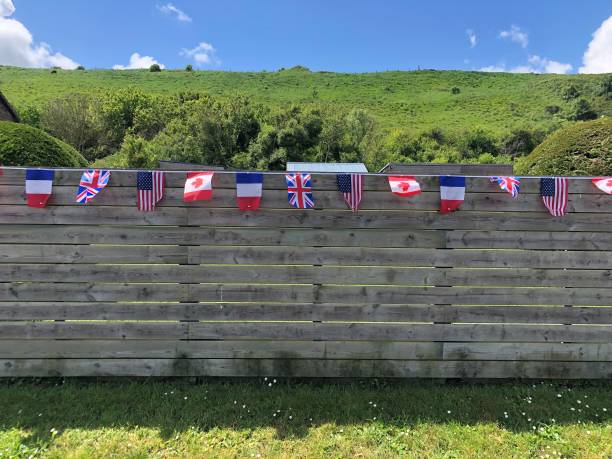Omanyano ovanhu koikundaneki yomalungula kashili paveta, Commisiner Sakaria takunghilile
Veronika Haulenga
Omanyano ovanhu koikundaneki yomalungula kashili paveta, Commisiner Sakaria takunghilile
Veronika Haulenga
Listeners:
Top listeners:
-
play_arrow
Omanyano ovanhu koikundaneki yomalungula kashili paveta, Commisiner Sakaria takunghilile Veronika Haulenga


By Matthieu CLAVEL
As the World War II victors celebrate the anniversary of the June 6, 1944, landings in Normandy, historians recall that 3,000 French civilians died under Allied bombs that day.
In an attempt to cut off German reinforcements rushing to the coast in response to the Allied invasion, American and British aircraft dropped bombs on main roads in several towns, including Caen, where the population believed — in error as it turned out — that it was safe to stay put during the raging battle on the coast.
“We saw bombs drop on Caen constantly,” said Fernande Mignon, 93.
“My mother persuaded my father to let us seek shelter in the quarries,” she told AFP at her home in Fleury-sur-Orne just outside Caen and close to where she grew up.
The move probably saved their lives.
Within 24 hours, 3,000 civilians had died in the firestorm unleashed by 1,500 bombers, including 700 in the town of Lisieux alone.
The number is comparable with the more than 4,600 Allied military personnel killed on D-Day, according to Commonwealth War Graves Commission figures.
Allied bombing missions reduced most town centres in lower Normandy to rubble.
After 10 weeks, the number of people who died in their homes in the area totalled 14,000.
“If the landings were to succeed, the bridgehead needed to hold for 48 to 72 hours,” said Emmanuel Thiebot, a historian and director of a memorial site dedicated to civilians in wartime.
“German reinforcements had to be slowed down for three days,” he told AFP.
Main roads always ran through city centres at the time — ring roads were to be introduced only after the war — which put the hearts of towns and villages including Vire, Conde-sur-Noireau, Pont-L’Eveque, Flers and l’Aigle on the fire-bombing target list of the Allied command.
Residents often stepped outside their homes to watch the planes approach, assuming that they were simply flying overhead to destinations further inland, historians Francoise Passera and Jean Quellien said in a 2014 book.
But then, to the dismay of the civilians, the bomb bay doors opened over their heads and the explosives dropped.
“There was a massive tremor. We held each other, thinking that we were done for,” the historians quoted a 15-year-old eyewitness as saying.
The teenage girl got away “by following mum’s and dad’s vague silhouettes in the blinding thick dust”, she said.
People exited their homes with blood streaming down their faces.
Some were buried alive in the rubble, while others were decapitated by shell fragments.
With hindsight, the strategic wisdom of targeting city centres was actually debatable, said Thiebot.
“The tactic was not very efficient in military terms — far from it — because the Germans kept clear of the major roads,” he said.
In fact, German reinforcements made it to the front line as early as the evening of June 6, with even more arriving the following day.
An earlier attempt by the Allies to get people to evacuate the area ahead of the assault came to little.
Pamphlets air-dropped three months before D-Day urging residents to leave “immediately” because the area “would come under attack very soon” were mostly ignored or lost in fields, unread.
Mignon ended up spending six weeks in the shelter of the quarry, sleeping on straw and living off “whatever we could find”, while relentless bombing continued out in the open.
Eventually, on July 19, a Canadian arrived, telling them in Quebec-accented French that the fighting was over.
“Everybody exploded with joy,” she said.
But the initial happiness quickly turned to consternation as the family discovered the destruction wrought on their neighbourhood and everything around it.
At the family home, “the windows were broken, doors were unhinged and rain was falling into the house”, she recalled.
It was to take “several years” before Mignon and her family managed to get back to a “normal life”, she said.
mac/jh/tgb/sjw/gil
AFP
(NAMPA / AFP)
Written by: Staff Writer
Allied bombs Allied landings American aircraft British aircraft Caen Canada Conde-sur-Noireau D-Day Emmanuel Thiebot Fernande Mignon Flers Fleury-sur-Orne France Francoise Passera German reinforcements great britain Jean Quellien l'Aigle Lisieux Normandy Pont-L'Eveque USA Vire World War II
Similar posts
Windhoek Weather
Most popular

Mbumba signs off new benefits for retired political office bearers

Former FNB employee arrested after defraud pensioner off N$215, 000

Namdia Heist: More questions, lots of confusion

Omuhwahwameki Michael okuunganeka oshikonga shoku patitha oostola dho Rani moshilongo ashihe.

Windhoek woman loses N$60,000 to fraudsters
Copyright 2025 Future Media (Pty) Ltd | Website by Digital Platforms
Tel: +264 83 000 1000 | Email: news@futuremedia.com.na





